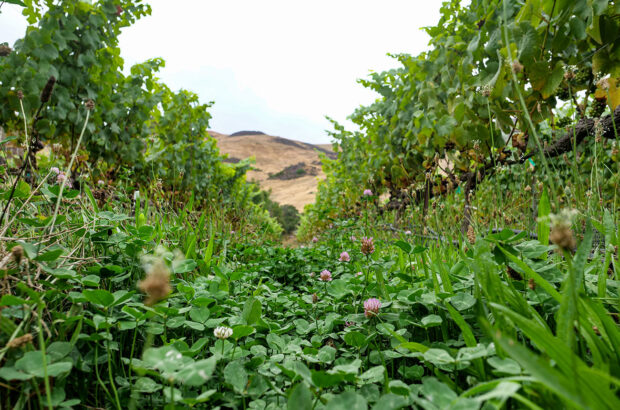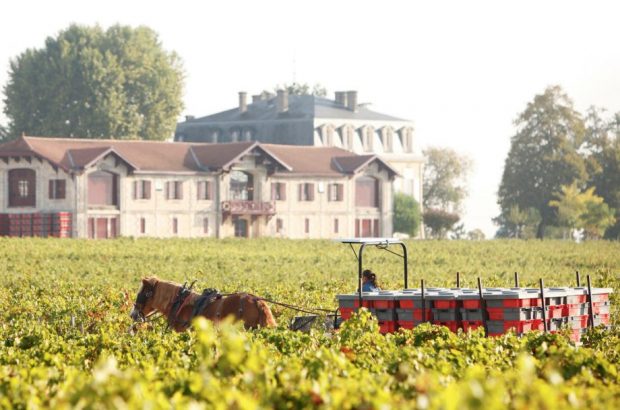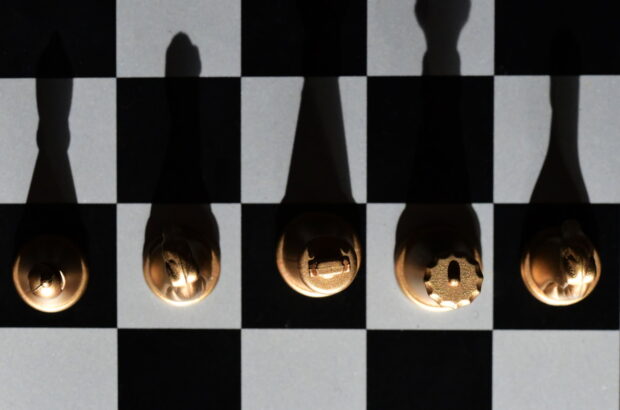A dinner scene in HG Wells’ The Time Machine depicts the sombre Time Traveller making ‘a motion towards the wine’. Offered ‘a glass of Champagne’, he drinks. ‘It seemed to do him good,’ writes Wells, ‘and the ghost of his old smile flickered across his face.’ Boarding the time machine to Wells’ 19th-century Britain, what would today’s wine lover encounter? And would it make you smile?
Innovations of the 19th century included bottles instead of casks, wine available at the grocer’s shop (in addition to the wine merchant), and expanding opportunities for women to partake in wine tasting amid polite society. Overall, wine quality improved, and some trends seem uncannily familiar, such as the natural wine movement, investing in wine, and steadily increasing diversity of wine styles, with myriad food pairings. So, was the world of wine really so different in the 19th century?
Grocery, wines and women
…In many ways, yes. Popping into the equivalent of Tesco or Sainsbury’s to buy a few bottles alongside some bread and cheese wasn’t so easy. Shopping involved visiting ‘the baker, the grocer, the wine merchant over the way’, according to the 1861 Temple Bar: A London Magazine for Town and Country Readers. In fact, the latest fad of allowing grocers to sell individual bottles of wine provoked great controversy in 1870s Britain. ‘This retail sale of wine is opposed,’ noted one commentary, ‘by the wine merchants and by the publicans’ afraid of losing business, but not only that.
‘It is alleged by teetotallers, and by many others’ that bottled wine so easily for sale on grocers’ shelves ‘greatly encourages intemperance’. An evil lurked behind ‘obtaining wine at such innocent-looking places as grocers’ shops’. Women, the argument went, now ‘indulge in secret drinking’, which could easily demoralise ‘great numbers of them’.
Indeed, women and wine did not go together at the century’s commencement. In finer homes, while women could participate in ‘the pleasures of the table’ with the ‘gentlemen’, after supper, ‘when the bottles, filled with Madeira, Burgundy, claret, or Port wine, begin to circulate briskly’ the ladies had to ‘retire to their own apartments’, explained the 1800 Lady’s Magazine. This custom waned. By 1865, the optimistically titled book Wine, as it is Drank in England: And as it Should Be, Pure, Wholesome and Refreshing remarked that ‘happily, the practice of soaking, “after the ladies have left the room”, is nearly extinct’. Women with wine knowledge became apropos.
Robert Druitt, a practising medic and popular writer, including on ‘cheap’ quality wines, even published ‘notes of what I think would be a useful lecture to ladies, should they desire to learn the elements of oenology’.
Wine quality

Luncheon Still Life by John F Francis, c.1860. Credit: Shawshots / Alamy Stock Photo
Maybe the ladies in 1800 were fortunate. For much of the century, the quality of newfangled, bottled retail ‘wine’ left much to be desired. There were ‘English wines’ and then there were ‘foreign wines’. One widely read guide offered instructions for making the ‘English’ styles, including claret, ‘Frontigniac’, Champagne and Port. Claret-making, for example, followed a straightforward recipe. ‘Take six gallons of water, two gallons of cyder, and eight pounds of Malaga raisins bruised; put them all together, and let them stand close covered in a warm place for a fortnight.’ Next, they added ‘a quart of barberries, a pint of the juice of raspberries, and a pint of the juice of black cherries’ plus ‘a little mustard seed’. Lacking a legal definition of wine, such preparations inundated the market.
Yet, with increasing wine knowledge and lower costs for a cascade of new imported wines, people began to avoid such concoctions. What did the middle classes at mid-century want? ‘A light, sub-fragrant wine of little strength, wholesome, and without the acidity’ that consumers ‘who love the fortified wines complain of so much in pure wine’, stated one commentator.
Buyer beware
What did a decent bottle of ‘foreign’ wine cost? Inexpensive wines could be bought, at ‘a variety of shops’, ‘at a moderate price’ of ‘at or under half-a-crown a bottle’ in the 1860s [£1 sterling in 1865 would be equivalent to about £160 today, according to CPI Inflation Calculator; hence half-a-crown, being two shillings and sixpence or one eighth of a pound, would equate to about £20 today]. Quality Port and Sherry, by contrast, came at ‘ruinously dear’ prices ‘if attainable at all’.
A wine boom occurred after the remission of wine duties enacted in 1860 by Gladstone as Chancellor under Prime Minister Palmerston, including a variety of ‘new kinds of wines’. Lower-priced Greek and Georgian wines became particularly popular. Even before Gladstone’s reforms, a ‘cheap Chablis’ of decent quality could be found in Soho for one shilling and sixpence a bottle [about £12 today].
The alcoholic strength of wines varied. According to various contemporary sources, including Druitt, Bordeaux claret averaged about 8.8%; Burgundies came in at around 10.5%, with Mâcon and Beaujolais slightly lower; Côtes du Rhône at 11% and Rhine wines a bit lower; natural Sherries were stronger, 13.5%, while Alicante clocked in at 14.45%. Port specially fortified for the British market: 17.7%.
Those wanting fine wine trusted specialist wine merchants. ‘He is a fool who thinks he gets better wine by importing’ than buying it from British merchants, noted a connoisseur. The reason was simple: ‘If I pay ready money, and I do not like the wine, I cannot send it back.’ Spoilage remained a common concern. The better merchants thrived on assuring quality wine suiting contemporary taste at the best price possible. Directly importing wine held allure but required buying ‘forty or fifty pipes’ [a large type of barrel commonly used for Port], and the calibre remained uncertain. ‘Am I to expect my pipe better than theirs? No, no; I know the contrary,’ wrote the aficionado.
Beefing it up

‘The vintage, in Médoc, near Bordeaux’ – specifically at Château Lafite Rothschild in 1854. Credit: 19th Era / Alamy Stock Photo
The contemporary British market demanded mostly blended wines. By the 1820s, English (though not Scottish) taste had turned decisively toward Port and Spanish vino, leaving vin de Bordeaux struggling to gain market share. A Bordeaux broker stated: ‘To give the Bordeaux wines some resemblance to those wines of Spain and Portugal which are used in England – to render them of the taste preferred in that kingdom from the effect of long habit – the greatest part of our wine merchants are obliged to work them.’ That meant blending, ‘a particular operation’. He observed that ‘the wines shipped for England are not pure when compared with those which remain at Bordeaux… The operation consists in mixing a certain quantity of fine strong wines of the south, which give fire to the claret’. Less respectable alterations occurred as well. ‘To give odour to the wine, they take two drams of orris-root in powder put into a fine rag, and let it hang about fifteen days in the cask.’ Such practices had long been the case.
Natural in the 19th
Such commercial practices, although driven by demand, resulted in a backlash: the ‘natural wine’ craze. In the early 19th century, references to natural wine noted its desirable qualities, but most consumers remained ignorant. That changed. By 1865, provocatively titled books such as Wine: The advantages of pure natural wine, and its special qualities for the Promotion of Health and Social Enjoyment appeared. Natural wine proponents defined it as ‘the term applied to the product which contains no other matter than the grape’, which may sound surprisingly familiar today.
The movement had two targets: Port and Sherry, ‘adulterated’ by the addition of brandy, burnt sugar and concentrated must, as well as those blended wines appealing to British taste. Purity being a ‘chief requisite’, wine should not ‘be contaminated by adulteration of any kind’ lest it lose ‘the delicate vinous flavour which is its peculiar excellence’. In fact, ‘no true connoisseur’ would drink it. Natural wine advocates clamoured that unfortunately the public remained ignorant of ‘the qualities of wine as it should be’. The movement demanded ‘an end to the disgraceful and pernicious system of wine adulteration’. It was even argued among theologians that ‘the wine that is a mocker is not the organ of divine, but rather of daemonic power’.
Investing & phylloxera

Ede & Son grocer, wine & beer merchant, probably in Epsom, Surrey, c.1890. Credit: Bridgeman Images
In the first half of the century, although the middle class bought much larger quantities at one time, most left wine investing to the merchants. By 1890, that began to change as French vintners suffered the ravages caused by the arrival of the phylloxera bug, which spurred the trend toward personal investment at the higher end. One expert noted that it was in ‘the interest of all claret consumers’ to invest ‘in good wines of a superior growth’. Wine lovers, he said, ‘be strongly advised to invest money in 1890 wines’. In that market, ‘1875 wines are purchasable at only very high prices, 1874 are becoming scarce, and even 1878 are beginning to be bought up so largely that they will not hold out very long’. Vintage advice came from négociants, such as Tastet & Lawton, who noted that the 1875s were ‘very good and elegant’ and Bordeaux had a ‘very good year’ in 1878.
Wine & food
At mid-century, another lasting trend arrived: the idea of well-chosen food and wine together. Previously, people imbibed wine solo, often after the meal, or at parties. Socialite ‘Frona’ Smith sought to introduce the latest British wine customs to California. She observed in 1889 that at the beginning of the century people offered ‘from ten to fifteen different wines or more’ with no connection to the food. But now, the popular advice from a British source was: ‘All wines ought to be dinner wines.’ Frona recommended that ‘from four to five different wines only were permitted to appear’ at the table. ‘The use of wine is to give appetite and relish for food,’ concluded another tract.
Nevertheless, many bons vivants at English dinner parties paid no heed to whether ‘Sherry follows or precedes Chablis’. They might ‘gulp down claret with sweets, or Burgundy with lobster salad’. Likewise, Frona observed: ‘A heavy wine, like a Port, or even a heavy claret, to a lover of good food, would be almost revolting if drank at the serving of oysters, or that of eggs.’ She added: ‘The utmost discrimination is necessary… to select wines that harmonise with the different dishes put upon the table, or vice versa.’
Scoring: Yes, even then

Workers preparing barrels at the sampling wharf at London Docks in 1893. Credit: Hulton Deutsch / Getty Images
In the 1880s, a new vogue emerged: rating wine with numerical scores. It started in Italy, but soon spread to England, France and the US. In 1879, Giovanni Rossi-Querce conducted a tasting in which 14 experts ‘had to vote by assigning the various wines (obviously with the bottles covered) from zero to 10 points’. By 1885, popular wine competitions used the 10-point merit scale (with half-points allowed), which led wine judge and oenology professor G Grazzi-Soncini, towards the end of the century, to include the novel idea in his short book Wine: Classification, Wine Tasting, Qualities and Defects. He indicated that ‘sometimes’ a taster can ‘conveniently express his verdict of quality by means of numbers’. The book soon saw translation into French and English, including by a pioneering researcher in California, where it had a huge influence.
The resemblance to wine critic Robert Parker’s 100-point system goes without saying. Most say that Parker’s introduction of scores in the late 1970s was novel, but wine history contains many such lessons.
Travelling in time back to the 19th-century’s world of wine demonstrates many differences with today’s wine culture, but also many trends and habits that appear quite familiar. In all, wine remains, as it was then, a passionate sphere of both controversy and delight, connected to all facets of human existence.
As Robert Druitt wrote in 1865, wine ‘gives variety, grace and refinement to our entertainments, and makes life probably longer, certainly better worth having’.












